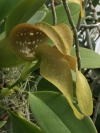|
|
|
|
 |
Email Address Recovery or Password Reset |
Use our Change Password page, and you can set a new password, or if you don't remember which email address you
registered with, the same page may be able to suggest it based on another you enter.
|
|
|
|
|
| |
Flasks of
Bulbophyllum grandiflorum 'Scott Thomas' CCM/AOS × self |
|
| |
|
|
| |
| Number: |
TN8438 |
| Name: |
Bulbophyllum grandiflorum 'Scott Thomas' CCM/AOS × self
|
| Type: |
self (What's that?) |
|
Seed Donor: |
Mr William Jasen
|
|
Click to Enlarge

Pod Parent Flower |
|
|
|
| |
Culture Notes from Donor: Parent plant: Temperature range Warm-Intermediate 87-64°F, cooler season Intermediate 83-60°F. Basketed with bark.
Comments: Parent plant: Medium-sized plant. Easy to grow, like a weed. Very floriferous with a dozen flowers at each blooming.
For additional origin/habitat information supplied courtesy of
Charles and Margaret Baker, see further below, near the bottom of this page.
|
Temperatures we attempt to use in the lab & greenhouse:
| For Species: |
|
Spring, Summer, Autumn, Winter: days average 85°F, nights 66°F; best fit is Warm-Intermediate 87-64°F
(Source:
Baker's Web OSC) |
|
About the name...
| Etymology of |
Bulbophyllum |
|
From Greek "bolbos" bulb; "phyllon" leaf.
(Source:
Pridgeon 1992) |
| Etymology of |
grandiflorum |
|
From Latin "grandiflorus" large-flowered.
(Source:
Mayr & Schmucker 1998) |
| Pronunciation of |
Bulbophyllum |
|
bul-bo-FILL-um
(Source:
Pridgeon 1992) |
| Pronunciation of |
grandiflorum |
|
gran-di-FLOE-rum
(Source:
Hawkes 1978) |
|
If you would like to direct someone to this web page, please copy and paste this URL into your email:
http://troymeyers.com/d?018438
| Flask Information |
| Availability: |
We have sold all of the flasks for this item. |
| You should: |
Consider getting individual plants or compots instead of a flask.
See if we have plants available in the greenhouse. |
| Yield Estimate: |
788 plants (based on flask surveys done 04/26/2018 through 04/30/2021)
|
| Plantlet Sizes: |
From many flasks 4 - 60 mm plants (based on flask surveys done 04/26/2018 through 06/21/2022)
From one most recently surveyed flask 20 - 40 mm (06/21/2022)
|
|
You might also want to:
|
View the seed assay for this item.
See if we have plants available in the greenhouse.
View items of the same species.
View items of the same genus.
|
| Ordering Information |
| You are not currently logged in. |
|
You must be a registered user and be logged in to reserve a flask or place a notification request. Please log in:
|
|
 |
Email Address Recovery or Password Reset |
Use our Change Password page, and you can set a new password, or if you don't remember which email address you
registered with, the same page may be able to suggest it based on another you enter.
|
|
|
|
|
|
|
|
| |
The origin/habitat information below is supplied courtesy of Charles and Margaret Baker
The following information is based on the name of the plant provided by the donor, and assumes that the name is correct. If the plant has been misidentified, then the following information may not be correct.
This text is copyrighted by the Bakers and may not be reproduced without permission.
ORIGIN/HABITAT: New Guinea and the Solomon Islands. This species is
distributed widely in both Papua New Guinea and Irian Jaya (Indonesian or
western New Guinea). In Papua, Schlechter found these plants in the Minjem
Valley at about 1650 ft. (500 m) and near Jaduna on the Waria River at
about 1000 ft. (300 m). This species reportedly also occurs in Sumatra,
the Celebes, and the Moluccas, but details of habitat locations and
elevations were not given. The plant that is now considered a synonym,
Bulbophyllum cominsii, is widespread in the Solomon Islands, growing in
coastal forests, mangrove swamps, and coconut plantations from near sea
level to about 150 ft. (50 m).
More about this information and the Bakers...
|
|
|
| |
|
|
|